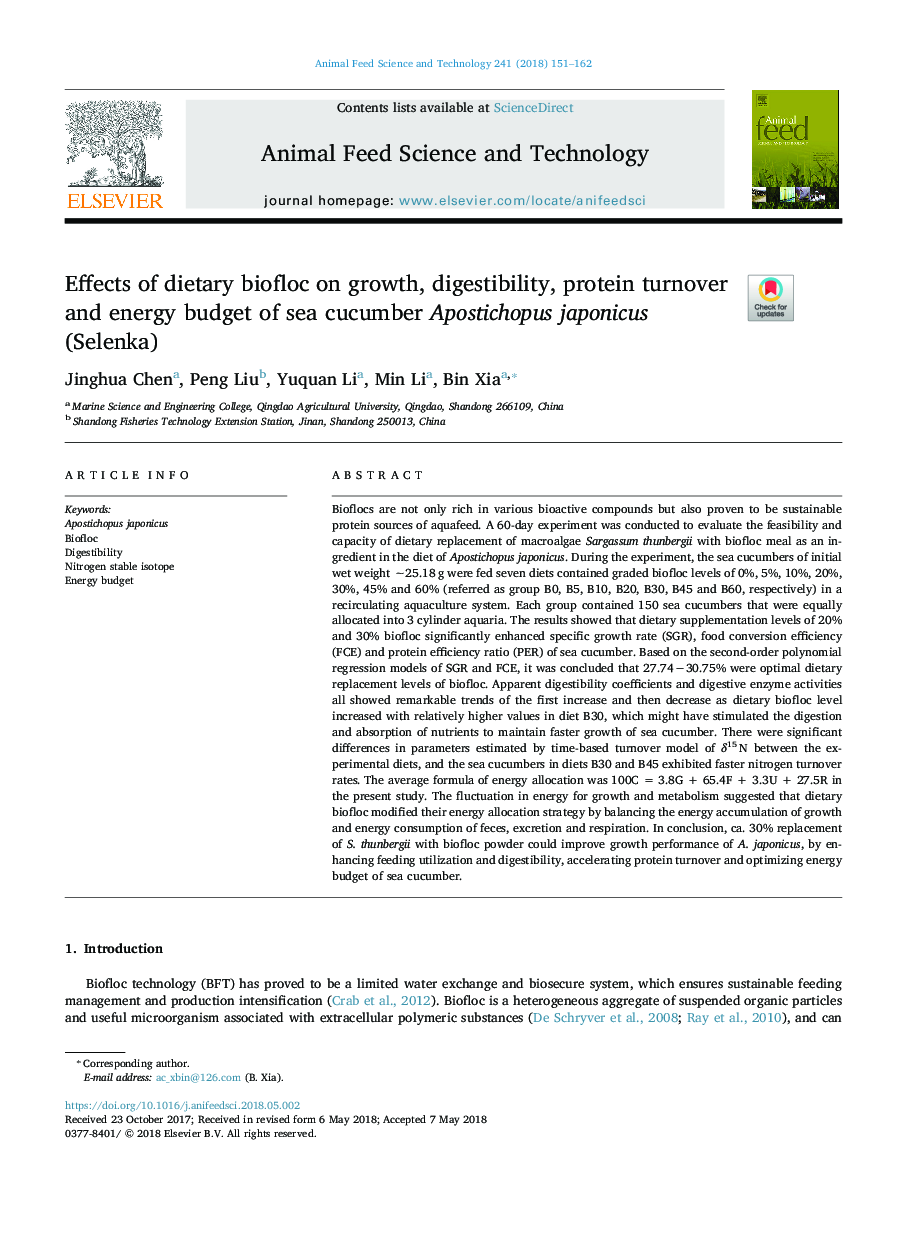| کد مقاله | کد نشریه | سال انتشار | مقاله انگلیسی | نسخه تمام متن |
|---|---|---|---|---|
| 8490948 | 1552345 | 2018 | 12 صفحه PDF | دانلود رایگان |
عنوان انگلیسی مقاله ISI
Effects of dietary biofloc on growth, digestibility, protein turnover and energy budget of sea cucumber Apostichopus japonicus (Selenka)
دانلود مقاله + سفارش ترجمه
دانلود مقاله ISI انگلیسی
رایگان برای ایرانیان
کلمات کلیدی
موضوعات مرتبط
علوم زیستی و بیوفناوری
علوم کشاورزی و بیولوژیک
علوم دامی و جانورشناسی
پیش نمایش صفحه اول مقاله

چکیده انگلیسی
Bioflocs are not only rich in various bioactive compounds but also proven to be sustainable protein sources of aquafeed. A 60-day experiment was conducted to evaluate the feasibility and capacity of dietary replacement of macroalgae Sargassum thunbergii with biofloc meal as an ingredient in the diet of Apostichopus japonicus. During the experiment, the sea cucumbers of initial wet weight â¼25.18â¯g were fed seven diets contained graded biofloc levels of 0%, 5%, 10%, 20%, 30%, 45% and 60% (referred as group B0, B5, B10, B20, B30, B45 and B60, respectively) in a recirculating aquaculture system. Each group contained 150 sea cucumbers that were equally allocated into 3 cylinder aquaria. The results showed that dietary supplementation levels of 20% and 30% biofloc significantly enhanced specific growth rate (SGR), food conversion efficiency (FCE) and protein efficiency ratio (PER) of sea cucumber. Based on the second-order polynomial regression models of SGR and FCE, it was concluded that 27.74â30.75% were optimal dietary replacement levels of biofloc. Apparent digestibility coefficients and digestive enzyme activities all showed remarkable trends of the first increase and then decrease as dietary biofloc level increased with relatively higher values in diet B30, which might have stimulated the digestion and absorption of nutrients to maintain faster growth of sea cucumber. There were significant differences in parameters estimated by time-based turnover model of δ15â¯N between the experimental diets, and the sea cucumbers in diets B30 and B45 exhibited faster nitrogen turnover rates. The average formula of energy allocation was 100C = 3.8G + 65.4F + 3.3U + 27.5R in the present study. The fluctuation in energy for growth and metabolism suggested that dietary biofloc modified their energy allocation strategy by balancing the energy accumulation of growth and energy consumption of feces, excretion and respiration. In conclusion, ca. 30% replacement of S. thunbergii with biofloc powder could improve growth performance of A. japonicus, by enhancing feeding utilization and digestibility, accelerating protein turnover and optimizing energy budget of sea cucumber.
ناشر
Database: Elsevier - ScienceDirect (ساینس دایرکت)
Journal: Animal Feed Science and Technology - Volume 241, July 2018, Pages 151-162
Journal: Animal Feed Science and Technology - Volume 241, July 2018, Pages 151-162
نویسندگان
Jinghua Chen, Peng Liu, Yuquan Li, Min Li, Bin Xia,